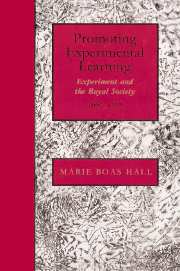Book contents
- Frontmatter
- Contents
- List of figures
- Preface
- A note on dates
- 1 Introductory
- 2 Aims and ideals
- 3 The record of the minutes 1660–1674
- 4 The communication of experiment 1660–1677
- 5 The record of the minutes 1674–1703
- 6 The communication of experiment 1677–1803
- 7 The record of the minutes 1703–1727
- 8 The communication of experiment 1703–1727
- 9 The view of the world; friend and foe
- Abbreviated titles
- Notes
- Bibliography
- Index
8 - The communication of experiment 1703–1727
Published online by Cambridge University Press: 03 December 2009
- Frontmatter
- Contents
- List of figures
- Preface
- A note on dates
- 1 Introductory
- 2 Aims and ideals
- 3 The record of the minutes 1660–1674
- 4 The communication of experiment 1660–1677
- 5 The record of the minutes 1674–1703
- 6 The communication of experiment 1677–1803
- 7 The record of the minutes 1703–1727
- 8 The communication of experiment 1703–1727
- 9 The view of the world; friend and foe
- Abbreviated titles
- Notes
- Bibliography
- Index
Summary
With the inauguration of Newton's Presidency, much was to change within the Society and with the perception of it by outsiders. Most strikingly, it is for this period impossible to separate the office from the office-holder, the Royal Society from its President, and Newton the natural philosopher from Sir Isaac Newton P.R.S. The two rapidly became one in most eyes, so that the Society received the credit for Newton's fame and influence, while he in turn took on the attributes of the Royal Society.
Relations between the Society and individuals at home and abroad were also coloured by the fact of Newton's Presidency. Sloane remained an active Secretary for ten years, corresponding as before with, particularly, natural historians, medical men, and his French friends (he joined Newton as an associé etranger of the Académie Royale des Sciences in 1709); after that as a Vice-President he presided at meetings when Newton was not present and of course continued much of his correspondence and influence, although less publicly. In 1713 Halley became Secretary so that now official correspondence took on a more astronomical bent. The publication of Opticks and the growing number of adherents to the Newtonian natural philosophy meant an enormous growth in knowledge and understanding of the Royal Society's empirical programme, now ineluctably merged with the dominating figure of its President, even though the cult of Newtonianism associated with the Enlightenment lay still in the future. Learned visitors were eager to view the Royal Society and its President, one of the essential ‘sights’ of London.
- Type
- Chapter
- Information
- Promoting Experimental LearningExperiment and the Royal Society, 1660–1727, pp. 133 - 139Publisher: Cambridge University PressPrint publication year: 1991



